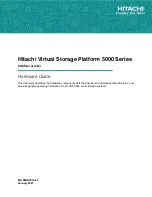
Parameter
Description
redundancyCheckEnabled
The setting to turn
on
or turn
off
redundancy checking
during a media scan. To turn
on
redundancy checking,
set this parameter to
TRUE
. To turn
off
redundancy
checking, set this parameter to
FALSE
.
segmentSize
The amount of data (in KB) that the controller writes on
a single drive in a logical drive before writing data on
the next drive. Valid values are
8, 16, 32, 64, 128,
256,
or
512
.
userLabel
The new name that you want to give an existing logical
drive. Enclose the new logical drive name in double
quotation marks (" ").
preReadRedundancyCheck
The setting to check the consistency of RAID redundancy
data on the stripes during read operations. Do not use
this operation for non-redundant logical drives, for
example RAID Level 0. To check redundancy consistency,
set this parameter to
TRUE
. For no stripe checking, set this
parameter to
FALSE
.
Notes
Host I/O errors might result in subsystems with more than 32 logical drives. This operation might also
result in internal controller reboots due to the expiration of the timeout period before the operation
completes. If you experience this issue, quiesce host I/O, and try the operation again.
When you use this command, you can specify one or more of the optional parameters.
You can apply these parameters to only one logical drive at a time:
v
addCapacity
v
segmentSize
v
userLabel
v
logicalUnitNumber
Add Capacity, Add Drives, and Segment Size
Setting the
addCapacity
parameter, the
addDrives
parameter, or the
segmentSize
parameter starts a
long-running operation that you cannot stop. These long-running operations are performed in the
background and do not prevent you from running other commands. To show the progress of
long-running operations, use the
show logicaldrive actionProgress
command.
The
addDrives
parameter supports both high-capacity drive expansion enclosures and low-capacity drive
expansion enclosures. A high-capacity drive expansion enclosure has drawers that hold the drives. The
drawers slide out of the drive expansion enclosure to provide access to the drives. A low-capacity drive
expansion enclosure does not have drawers. For a high-capacity drive expansion enclosure, you must
specify the identifier (ID) of the drive expansion enclosure, the ID of the drawer, and the ID of the slot in
which a drive resides. For a low-capacity drive expansion enclosure, you need only specify the ID of the
drive expansion enclosure and the ID of the slot in which a drive resides. For a low-capacity drive
expansion enclosure, an alternative method for identifying a location for a drive is to specify the ID of
the drive expansion enclosure, set the ID of the drawer to 0, and specify the ID of the slot in which a
drive resides.
Chapter 3. Script Commands
3-225
Summary of Contents for System Storage DS3000
Page 599: ...Appendix A Examples of information returned by the show commands A 3...
Page 601: ...Appendix A Examples of information returned by the show commands A 5...
Page 603: ...Appendix A Examples of information returned by the show commands A 7...
Page 605: ...Appendix A Examples of information returned by the show commands A 9...
Page 607: ...Appendix A Examples of information returned by the show commands A 11...
Page 609: ...Appendix A Examples of information returned by the show commands A 13...
Page 611: ...Appendix A Examples of information returned by the show commands A 15...
Page 623: ...Appendix A Examples of information returned by the show commands A 27...
Page 625: ...Appendix A Examples of information returned by the show commands A 29...
Page 627: ...Appendix A Examples of information returned by the show commands A 31...
Page 651: ......
Page 652: ...Part Number 00W1466 Printed in USA GA32 0961 05 1P P N 00W1466...
















































